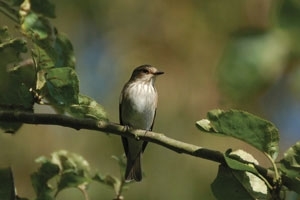Muscicapa striata
 Spotted flycatchers have declined substantially in recent years and are designated as a Biodiversity Action Plan (BAP) species. They are popular birds as they frequently nest close to house walls or in hanging baskets. They fly from prominent perches to catch insects, and are an endearing sight in country villages, so it is sad that their numbers have declined by about 80% over the past three decades.
Spotted flycatchers have declined substantially in recent years and are designated as a Biodiversity Action Plan (BAP) species. They are popular birds as they frequently nest close to house walls or in hanging baskets. They fly from prominent perches to catch insects, and are an endearing sight in country villages, so it is sad that their numbers have declined by about 80% over the past three decades.
Flycatchers cross the Sahara twice a year on their way to and from wintering areas in sub-Saharan Africa, where a loss of woodland may have reduced survival. Another explanation is that breeding success has fallen because of fewer insects, loss of habitat, and because of increased predation by woodland predators such as grey squirrels. The change in predator control at Loddington has provided a chance to look at how spotted flycatchers respond to gamekeeping.
Flycatcher pairs increased at Loddington between 1992 and 2001 during our period of predator control, but declined after 2002 when predator control stopped. This year’s delay in the decline following cessation of predator control is indicative of a change in numbers resulting from reduced nesting success. Most of this change in number was attributable to the establishment or abandonment of breeding territories in woodland, whereas numbers of breeding territories in village gardens remained largely unchanged through this period .
This initial increase, followed by a decline, is unlike the national trend where there has been a sustained decline throughout this period. As a migratory species, spotted flycatchers cannot have been affected by the abundance of winter food at Loddington, which appears to have influenced numbers of non-migratory species there, but must have been influenced by our management in summer.
During our nest monitoring, we found that nests were made broadly in either woods or in village gardens. The nests themselves could be in cavities, creeping plants on tree trunks, walls, or in three cases, in old thrush nests. Some were more than nine metres off the ground but three metres was more typical. Nest survival to fledging was 73% in the years with predator control, but only 26% in the years without it. In the absence of predator control there were differences between habitats, with nest survival in gardens being 75%, whereas that in woods was just 20%.
It seems that predation does reduce the breeding success of spotted flycatchers at Loddington, especially in woodland, and this is a likely explanation for reduced breeding numbers in subsequent years. This is one bird which certainly appears to benefit from predator control carried out for game.

Download Peter Thompson's essential 26-page book, featuring beautiful photography and detailed profiles of Britain's wildlife
Download FREE >